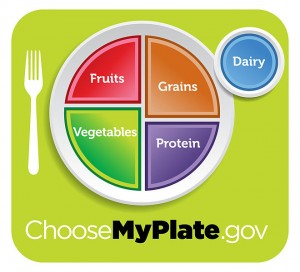 Yesterday, First Lady Michelle Obama along with the U.S. Department of Agriculture, said farewell to the iconic food pyramid as they unveiled its replacement in Washington DC. The food pyramid, which was first introduced in 1992 has long been criticized for its inability to properly convey healthy eating habits and is often associated with the increased rate of obesity in the United States.
Yesterday, First Lady Michelle Obama along with the U.S. Department of Agriculture, said farewell to the iconic food pyramid as they unveiled its replacement in Washington DC. The food pyramid, which was first introduced in 1992 has long been criticized for its inability to properly convey healthy eating habits and is often associated with the increased rate of obesity in the United States.
The guidelines for wholesome eating are newly represented by a simple circle referred to as “MyPlate,” a design which is intended to simulate a dinner plate. The plate is divided into different sections with a nearby circle representing a dairy serving. On the plate, fruits and vegetables occupy one half while the second half is comprised of grains and proteins.
The new food image is expected to successfully complement Michelle Obama’s “Let’s Move!” initiative to help alleviate the threat of obesity but as former Food and Drug Administration commissioner, Dr. David Kessler appropriately points out, the challenge lies in the ability to motivate people to actually eat what is depicted on the plate. One recommended solution is to utilize promotional food and drink products to reinforce the importance of healthy eating habits. Nuts, such as cashews, pistachios, and almonds, are an excellent source of protein and can easily be packaged and distributed as promotional food and drink products to appeal to both children and adults.
Even though this is not the first time a modern interpretation has been presented, nutritionists and industry food specialists seem pleased to see that the food pyramid is no longer. For decades, the federal government has attempted to establish a graphic that the general public can use as a reliable nutritional guideline. As early as 1946, an image dubbed “Basic Seven” categorized foods into seven recommended groups, one of which was butter. In 1956, “Essentials of an Adequate Diet” replaced the seven groups with just four and focused mainly on ensuring sufficient food consumption.
The longest running icon, employed from 1958 to 1979, maintained the importance of four equal sections of meat, dairy, grains, and fruits and vegetables, but also cautiously introduced a section of fats, oils, and sweets. In 1992, the USDA introduced the “Food Pyramid,” where bacon confusingly seemed equal to lean poultry, and then thirteen years later, slight alterations presented the public with “MyPyramid” and an incorporation of a flight of stairs to encourage exercise. The many problems associated with the most recent food pyramid undeniably prompted a revamp. So far, the “MyPlate” has received favorable reactions from a number of food service organizations for its concise and easy-to-understand incorporation of the four major food groups but whether this latest version will satisfy long term efforts to appeal to the public and encourage healthier food choices is simply unknown.
Do you think the “MyPlate” image will stick around for a while? Let us know in the comments section below.
Kim M.
Creative Writing Intern